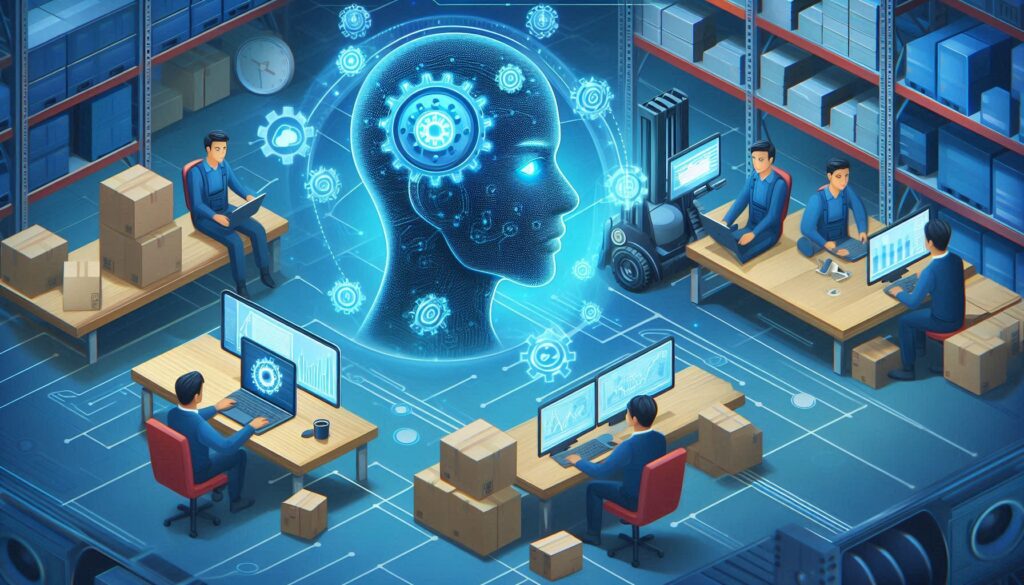To remain competitive and succeed in today’s global marketplace, companies need to run their organizations like a fine-tuned engine to sustain growth. With that in mind, businesses that use transformative artificial intelligence (AI) technologies are well-positioned to conquer challenges and better manage their supply chains while improving costs and enhancing efficiency, operations, performance, and the customer experience. One of the most critical ways AI revolutionizes supply chain management is through predictive analytics. AI can accurately predict future demand by analyzing data, allowing companies to optimize inventory levels, streamline supply chain processes, and reduce the risk of stockouts or overstocking. This type of supply chain automation is only possible with AI.

Benefits of using AI in supply chain management
Effective supply chain management (SCM) is essential to optimizing the flow of products and services and streamlining business operations. From procuring raw goods to managing reliable suppliers to automating various warehouse processes to optimizing shipping routes and delivery times, every point in the supply chain must work efficiently to improve a company’s bottom line and ensure a competitive advantage.
Many companies already see the advantages of automating supply chain tasks through AI, including back-office and warehouse logistics, quality checks, inventory management, and supplier relationship management. By leveraging AI in the quality control of supplier management, companies can automate manual and time-consuming tasks, improve accuracy, efficiency, and sustainability, and achieve greener warehouse processes. According to research, 37 percent of businesses, including supply chain companies, already see the benefits of AI solutions. AI will also contribute $15.7 trillion to the global economy by 2030.
When the supply chain is fully optimized with successful SCM, companies are likely to experience these benefits:
Decreased operating costs. Companies can lower operational costs by reducing purchasing and production expenses. For example, suppose a grocery store owner buys fresh vegetables directly from the farmer. Eliminating the expense of using a third party to purchase products can save money and vegetables are available in the store faster. Additionally, AI provides data transparency for better supply chain visibility and cost savings.
Better productivity and reduced labor costs. Leveraging AI enables manual work to be done more efficiently by automating manual tasks. It’s estimated that 40 percent of the workload during the sales process can be automated through AI solutions. This decrease in human labor reduces operating costs.
Improved relationships with suppliers, manufacturers, and distributors. When relationship management works well and all parties, including suppliers, manufacturers, retailers, and planners, work collaboratively, companies can avoid overstock or out-of-stock scenarios.
Shorter delivery times and on-time delivery. AI can track shipments and facilitate the on-time delivery of goods by analyzing data and identifying patterns, helping managers make better decisions. Walmart uses AI to analyze sales patterns and optimize inventory levels, reducing product stockouts and getting fresh food to shoppers faster. This leads to enhanced customer satisfaction.
Improved transportation network and routes. AI finds the most efficient and cost-effective way to transport goods by analyzing the number of trucks needed, the fuel consumed, and the time it takes to get from point A to point B. For example, UPS integrated AI into its logistics operations to optimize route planning and package delivery. AI also analyzes weather conditions and traffic patterns, helping reduce fuel consumption and enhance delivery automation and accuracy.
Reduced risks. AI provides data on warehouse management systems and identifies weaknesses, gaps, and risks. Businesses create a safer work environment and a more efficient supply chain by identifying potential risks and taking proactive steps to correct them.
Enhanced decision-making capabilities. AI’s ability to analyze mass data in minutes facilitates critical decision-making. Yet, AI doesn’t replace humans. Instead, it provides increased data visibility and insights that facilitate faster, more accurate, and more precise decisions.